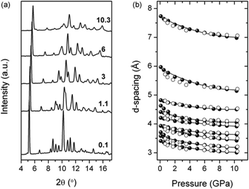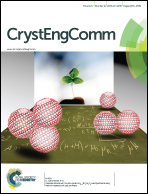Exploring the pressure–temperature behaviour of crystalline and plastic crystalline phases of N-isopropylpropionamide†
Abstract
The phase behaviour of crystalline and plastic crystalline phases of N-(isopropyl)propionamide (NiPPA) has been investigated by X-ray diffraction and a tentative P,T diagram has been constructed. The observed phase transitions are highly dependent on kinetics, and metastable co-existence of both phases can be observed. At lower pressures (up to 400 MPa) the plastic crystalline phase transforms into the crystalline phase as observed for other plastic crystalline systems, although the slopes (dT/dP) for both the liquid-to-plastic crystal and plastic crystal-to-crystal transitions are both positive and likely to run nearly parallel to each other. Higher pressures result in a highly anisotropic deformation of the crystal packing and at around 4 GPa the NiPPA crystals undergo a isosymmetric phase transition. An instability is observed at 350 K and 1400 MPa where the crystalline X-ray diffraction pattern is lost during heating accompanied by a rapid drop in pressure of the cell. This may correspond to a melting event characterised by a negative dTm/dP slope.


 Please wait while we load your content...
Please wait while we load your content...